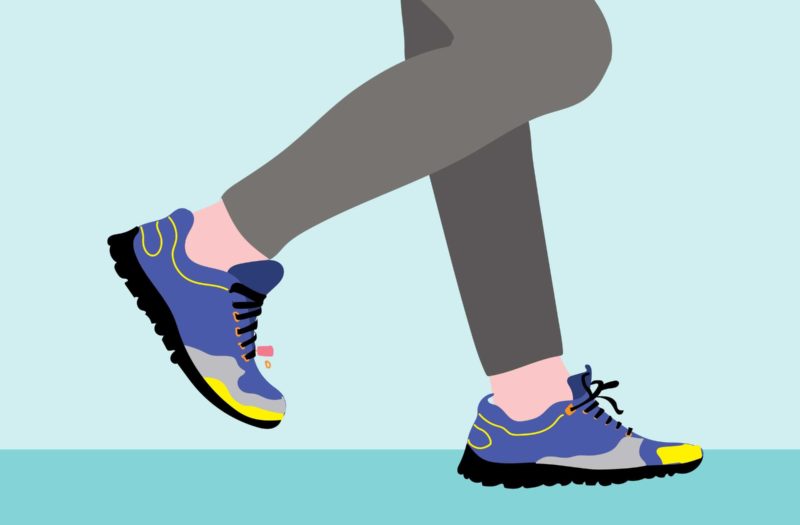Walking is hands-down — um, feet-down — one of the best ways to exercise when you have arthritis. It’s free, you can do it around your neighborhood or even just around your home, and you can walk for as long or as little or as fast or slow as you’re physically able.
And during the coronavirus pandemic — when those with chronic illnesses, underlying health issues, and suppressed immune systems are trying to practice social distancing and avoid crowded and potentially germy places like the gym, but still need to exercise — walking outdoors in non-crowded areas is a great option.
And there are lots of research studies that point to specific benefits for those with arthritis joint pain, stiffness, and fatigue. To name a few benefits:
- Low-impact exercise like walking improves blood flow to cartilage, which helps it stay healthy.
- Regular Movement helps your joints stay lubricated, preventing stiffness.
- Walking helps maintain muscle tone, which is important to support bones and joints.
- Walking helps with maintaining a healthy weight, which reduces pressure on the joints.
However, we know that exercise can be a double-edged sword when you have chronic pain. When you hurt, getting up and working out is one of the last things you want to do. Unfortunately, this can create a vicious cycle: Pain makes moving more difficult, so you move less. And the more inactive you become, the more painful your joints become.
That’s why we created this monthlong walking workout plan, which has modifications and adjustments for various fitness levels. This plan was created by Michele Stanten, an American Council on Exercise (ACE)-certified fitness instructor and walking coach who has been motivating people to be more active for more than 20 years. Stanten is the author of the books Firm Up in 3 Weeks and Walk Off Weight and has produced and appeared in more than a dozen exercise DVDs and created numerous audio workouts. Read more about her background.
You should always talk to your doctor before starting any new exercise plan to make sure it’s safe and appropriate for you.
Week 1
Walking is low impact so it’s gentler on your joints than activities like jogging. You can do it anywhere, even just around your home. While exercise guidelines recommend 150 minutes of moderate-intensity aerobic exercise (a.k.a. walking, cycling, jogging, Zumba) a week — 30 minutes, five days a week — that may not be right for you right now, and that’s totally fine.
Right now, your goal should be to do a little more than what you’re currently doing and gradually work up to the recommended levels based on your abilities, even if it takes several months or a year or more. By doing even a little more, you’re still reaping benefits.
Here are three ways to add more walking to your day, depending upon your current level of activity, fitness level, and how you’re feeling today.
Goal: Walk at a comfortable speed for five minutes and do it two times today, for a total of 10 minutes of walking.
Step it down: Walk for just a minute and do it 10 times today, for a total of 10 minutes of walking. If that’s too much, do 30 seconds of walking 20 times. If you can’t do all of it, that’s OK. Keep at it and you’ll see an improvement.
Step it up: Walk for 10 minutes all in one shot. You can also pick up the speed or walk for more time if you’re up to it.
You can do this every day this week or as many days as you feel comfortable.
Week 2
The more you do, the more benefits you’ll receive. This week, add five more minute of walking to your day — and repeat as frequently as you like over the next week. If you’re not feeling up to doing more yet, that’s OK. Stick with the 10 minutes from last week and increase when you are ready.
Goal: Walk for five minutes and do it three times today, for a total of 15 minutes of walking.
Step it down: Walk for just a minute at a time. Do this 15 times today for a total of 15 minutes of walking.
Step it up: Walk for 15 minutes all in one shot. You can also pick up the speed or walk for more time if you’re up to it.
You can do this every day this week or as many days as you feel comfortable.
Week 3
Along with increasing the amount of walking that you’re doing this week (if you feel up to it), pay a little attention to your posture. Is your head up? Are you standing tall? Are your arms swinging freely? Are your shoulders down and back? Are your feet landing quietly and rolling from heel to toes? Pick one area and focus on improving it. Good posture and technique make walking more enjoyable.
Goal: Walk for 10 minutes and do it two times today, for a total of 20 minutes of walking.
Step it down: Walk for two minutes and do it 10 times today for a total of 20 minutes of walking.
Step it up: Walk for 20 minutes all at once. Need more of a challenge? Walk a little faster.
You can do this every day this week or as many days as you feel comfortable.
Week 4
Each week, your new walking prescription is challenging your body so you continue to see improvements. But different bodies need different approaches. Don’t worry if you’re not ready for this week’s plan. There are other ways to mix it up and keep making progress. You could stick with last week’s routine and walk an extra day or two this week. Or go back to one of the previous weeks and modify it slightly. For example, if you did the two-minute walks last week, try adding in some of the first week’s five-minute walks. Every extra step you take will bring you one step closer to feeling better.
Goal: Walk for 10 minutes and do it three times today, for a total of 30 minutes of walking.
Step it down: Walk for three minutes and do it 10 times today for a total of 30 minutes of walking.
Step it up: Take a 30-minute walk. It’s OK to stop and rest along the way if you need. Or pick up the pace for a minute or so when you’re feeling good and repeat as often as you like if you want to do more.
You can do this every day this week or as many days as you feel comfortable.
Track Your Symptoms with ArthritisPower
Join CreakyJoints’ patient-centered research registry and track symptoms like fatigue and pain. Learn more and sign up here.
Keep Reading
Exercise helps ease arthritis pain and stiffness. Mayo Clinic. https://www.mayoclinic.org/diseases-conditions/arthritis/in-depth/arthritis/art-20047971.
Exercise is good, not bad, for arthritis. Harvard Health Publishing. https://www.health.harvard.edu/blog/exercise-is-good-not-bad-for-arthritis-201305086202.
Physical Activity for Arthritis. U.S. Centers for Disease Control and Prevention. https://www.cdc.gov/arthritis/basics/physical-activity-overview.html.






